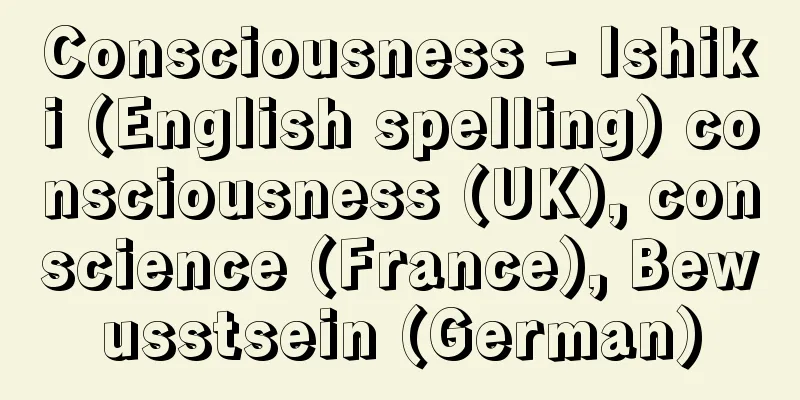Consciousness - Ishiki (English spelling) consciousness (UK), conscience (France), Bewusstsein (German)

|
Consciousness has multiple meanings, but generally it refers to the state of mind in which one is aware of one's current state and the situation around oneself. Consciousness is a subjective phenomenon and cannot be reduced to other events. It is also used to refer to awareness through attention or the process of awareness. When consciousness is disturbed, transient or persistent loss of thinking ability, stupor, lethargy, or coma are observed, and abnormalities are observed in electroencephalograms, etc. Being aware of the self that one sees and hears as a direct experience is considered to be consciousness through awareness of the external world, while being aware of the prospect of resolving a problem when one has oneself is considered to be consciousness through internal awareness. In this sense, consciousness can be said to be an intentional state of mind that is born in the process of experiencing the self as a subject through awareness of the internal and external environment. However, consciousness is limited, so not all experiences and actions are necessarily conscious. It is thought that this limitation is due to the limited and selective nature of the mechanism responsible for the intentional mind, known as awareness. While brain activity is closely related to consciousness, it has also been found to be related to unconscious mental states (for example, in psychoanalysis, consciousness is considered to be the bearer of adaptive functions, but the dynamics of the unconscious are the focus). [Brain and consciousness] Consciousness was a central theme in the epistemology and ontology of philosophy throughout ancient, medieval, and early modern times. At one time, the epiphenomenon theory (Huxley, TH, 1874) was advocated, which states that consciousness is merely a by-product of processes in the brain. Consciousness has a long history of philosophical exploration, but it has only recently become the subject of scientific research. Since Descartes, R. proposed mind-brain (body) dualism in the 17th century, the question of how the physical brain generates subjective consciousness has been considered a major problem that modern science must solve. By separating the body and consciousness, Descartes explained the body mechanically, while conceiving of substance dualism, which regards consciousness and the mind as rational subjects that think. On the other hand, Descartes found the self as a thinking subject in the proposition "I think, therefore I am," and by showing that the mind has the function of self-awareness, he considered consciousness to be a function of the mind unique to humans, laying the foundation for the scientific study of consciousness. He believed that the two entities of matter and consciousness interact in the pineal gland in the brain, but the idea that consciousness is related to a specific area of the brain is considered incorrect by modern science. One example that shows the difficulty of scientifically studying consciousness is qualia, which refers to the quality of subjective sensations. Chalmers, D. believes that it is difficult to scientifically explain qualia, and calls it a hard problem. The possibility of its expression in the brain is still debated. In recent years, advances in cognitive neuroscience have made it possible to observe some of the functions of consciousness using functional magnetic resonance imaging (FMRI) and other techniques, suggesting that they are deeply related to psychological indicators that represent the subjective state of the mind. Depending on how one interprets the relationship between brain activity and consciousness, there are various theories, ranging from the extreme mind-brain identity theory, which claims that consciousness can be completely reduced to brain processes, to mind-brain dualism, but it has become clear that some types of consciousness are related to the activity of networks in specific brain regions. The general idea is that there is a causal interaction between consciousness and the brain, and with the progress of integrated research into experimental psychology and neuroscience, consideration has been added from the perspective of neural correlates of consciousness (NCC). As a result, it has become clear that consciousness does not involve the entire brain, but that different brain regions work in cooperation (or inhibit each other) depending on the problem to be solved. This indicates that when a specific brain region is damaged, the corresponding function of consciousness changes. Taking the example of visual consciousness disorders, for example, in cases of blindsight, the visual cortex of the brain is damaged, and even if the subject can no longer see the object, it is possible to accurately determine the direction of a moving stimulus. In other words, the subject sees without being conscious of what he or she is looking at. Blindsight can also be considered unconscious consciousness, and is helpful when considering what consciousness is. Looking at the modern history of approaches to consciousness, behaviorism excluded consciousness from the subject of study because it was subjective and unobservable, but consciousness and attention have become important research themes in the cognitive approach that became mainstream in the latter half of the 20th century. The science of consciousness today has become a broad-based field that broadly involves cognitive sciences such as cognitive psychology, cognitive neuroscience, and philosophy of mind. In this field, consciousness is often explained functionally, with intentionality being associated with functionality, and functionality being associated with purpose. Functionalism refers to the ideological position of James, W. and others who emphasized the fluid function and action of consciousness. It is opposed to the constructivism of Wundt, W. and Tichener, E. B., who considered consciousness to be composed of a complex of elements such as sensations, emotions, and ideas, and that elements can be analyzed through introspection. The action psychology and Gestalt psychology of Brentano, F., Stumpf, C., and others also emphasized the action and wholeness of consciousness. In the scientific study of consciousness, the predominant position is a functionalist cognitive approach, which assumes that information represented in the brain becomes the content of consciousness and that this becomes intentional. Functionalism is also behind James' idea of the stream of consciousness, which states that consciousness is a continuous flow that never stops. He also called the less clear consciousness around the central part of consciousness the fringe of consciousness. Working memory is a goal-oriented consciousness that operates mainly in the frontal lobe, has capacity limitations, and is closely related to awareness, but consciousness can also be thought of as an active memory that carries current experiences. [Hierarchy of consciousness] The idea of hierarchies or stages in the functioning of consciousness has been around for a long time. Leibniz, GW, considered three stages, such as perception, recollection, and apperception, while Wolff, C., stated that there are stages from clear to unclear, and presented the idea of clarity of consciousness (Klarheit des Bewusstseins). In Bund's psychology of consciousness, the range of clear consciousness was called the attentional field or the mind. The expression degree of consciousness was sometimes used to indicate the clarity and level of consciousness. Both assume a hierarchy of consciousness. In the three-hierarchy model of consciousness from a biological standpoint, the first layer is considered to be the foundation, arousal, the second layer is intermediate consciousness led by awareness, that is, perceptual consciousness related to external world recognition (and motor consciousness that produces adaptive behavior to the external world), and the third layer is assumed to be higher-level self-consciousness and social consciousness. Self-consciousness requires the ability to recursively monitor one's own mental states, and it is believed that self-awareness extends to the problem of estimating the mental states of others (theory of mind) and even social consciousness related to the relationships between the self and others. In this model, consciousness can be viewed from a broad perspective across all living organisms. The top-level third layer of consciousness can be said to be unique to some primates and humans, but the first and second layers of consciousness can be seen in animals in general. In terms of its relationship to the brain, it is thought that the first layer is the brain stem, such as the thalamus, the second layer is mainly the brain areas of the neocortex involved in perception and movement, and the third layer is the temporal and medial prefrontal cortex, which read the minds and intentions of others, all working together. Higher-level representations in the brain are a major research topic in the social brain and social neuroscience. Buddhist thought also assumes eight types of mental consciousness (eight consciousnesses) and 51 related mental factors, and considers the Alaya consciousness that corresponds to the unconscious (Chiba Insei, 1957). Japan's unique theories of consciousness include Chiba Insei's theory of inherent consciousness, Sakuma Kanae's theory of basic consciousness, and Kuroda Ryo's theory of intuition. →Functionalism →Structuralism →Psychoanalysis →Unconscious →Yuishiki Psychological Thought [Osaka Naoyuki] Latest Sources Psychology Encyclopedia Latest Psychology Encyclopedia About Information |
|
意識には多義的な意味があるが,一般的には現在経験している自分の状態や周囲の状況などを感知している心の状態を指す。意識は主観的な現象であり,他の事象に還元することはできない。注意による気づきawareness(アウェアネス),あるいはその過程を示す場合にも使われる。意識障害disturbance of consciousnessになると一過性あるいは持続性の思考能力の喪失,昏迷,嗜眠や昏睡などが観察され,脳波などに異常が観察される。直接経験として見たり聞いたりしている自己に気づくのは,外界への気づきによる意識であり,問題を抱えているときにその解決の見通しに気づいたりするのは内的な気づきによる意識と考えられる。この意味では,意識は内外の環境への気づきによって,主体としての自己が経験される過程で生まれる志向的な心の状態であるといえる。 しかし,意識には制約性が伴うので,すべての経験や行動が必ずしも意識されるとは限らない。この制約があるのは,気づきという志向的な心を担う機制に制約性と選択性があるためだと考えられている。脳の活動は意識と密接にかかわる一方で,同時に無意識な心的状態ともかかわることがわかってきた(たとえば,精神分析では意識は適応機能の担い手とされるが,無意識についてはその力動性に注目する)。 【脳と意識】 意識は古代,中世,近世を通して哲学の認識論・存在論の中心的テーマであった。意識は脳内過程の副産物にすぎないとする随伴現象説(Huxley,T.H.,1874)が唱えられたこともあった。意識は長い哲学的探究の歴史をもつが,それが科学的研究の対象となったのは最近のことである。17世紀にデカルトDescartes,R.が心脳(身)二元論を提唱して以来,物理的な脳が主観的な意識をどのように生み出すのかという疑問は近代科学の解くべき大きな問題と考えられてきた。身体と意識を分離させることで,デカルトは,身体を機械論的に説明する一方,意識や心を考える理性的主体としてとらえる実体二元論を考えた。一方,デカルトは思考する主体としての自己を「われ思うゆえにわれあり」という命題に見いだし,心が自己認識の働きをもつことを示すことで,意識をヒトに固有の心の働きと考え,意識の科学的研究の礎を築いた。彼は物質と意識という二つの実体が脳内の松果体で相互作用すると考えたが,このような意識が脳の特定の領域とかかわるという考えは,現代科学からは誤りとされている。意識の科学的研究の難しさを示す例として,主観的な感覚の質を指すクオリアqualiaがある。チャルマースChalmers,D.はクオリアの科学的解明は困難であると考え,これをハードプロブレムhard problemとよんだ。その脳内表現の可能性については論議が続いている。 近年,脳の認知神経科学の進展により,意識の働きの一部が機能的磁気共鳴画像法(FMRI)などで観察できるようになり,心の主観的状態を表わす心理的指標とも深くかかわることが示唆されている。脳の活動と意識のかかわりをどうとらえるかによって,意識を脳の過程に完全に還元できるという極端な心脳同一論から心脳二元論までさまざまな考えがあるが,ある種の意識は特定の脳領域のネットワークの活動とかかわることがわかってきた。意識と脳の間には因果的な相互作用があると考えるのが一般的な考え方であり,実験心理学と神経科学の融合的研究が進展し,意識の神経相関neural correlates of consciousness(NCC)の視点から検討が加えられるようになってきた。その結果,意識の働きが脳全体にかかわるのではなく,解決すべき課題によって,異なる脳領域が協調して(あるいは抑制し合いながら)働く,ということがわかってきた。これは,特定の脳領域がダメージを受けると,対応する意識の働きが変わることを示している。視覚的な意識の障害を例に取ると,たとえばブラインドサイト(盲視)blindsightの症例では,脳の視覚野がダメージを受けて,対象が見えなくなっても運動刺激の方向などを判断させると的確に言い当てることができる。つまり,見ているものを意識することなしに見ているのである。ブラインドサイトは無意識の意識とも考えられ,意識とは何かを考える際に参考になる。 意識へのアプローチを近代の歴史から見てみると,行動主義は,意識を主観的で観察できないものとして研究対象から排除したが,20世紀後半に主流となった認知的アプローチでは意識や注意は研究の重要なテーマとなっている。現在の意識の科学は認知心理学,認知神経科学,心の哲学などの認知諸科学が広くかかわる広領域の学問となってきた。ここでは,意識は志向性として,志向性は機能性として,さらに機能性は目的性と関連づけられて機能主義的に説明されることが多い。機能主義functionalismは,意識の流動的な機能や作用を重視したジェームズJames,W.などの思想的立場を指すもので,意識を感覚,感情や観念などの要素の複合体から構成されると考え,要素は内観によって分析できるとしたブントWundt,W.やティチェナーTichener,E.B.の構成主義に対するものである。ブレンターノBrentano,F.,シュトゥンプStumpf,C.らの作用心理学やゲシュタルト心理学でも意識の作用や全体性が重視された。意識の科学的研究において,有力な考え方は機能主義的な認知的アプローチを取る立場で,脳内で表象された情報が意識の内容となり,これが志向性を帯びると想定する。 意識は停止することのない連続した流れであるとしたジェームズの意識の流れstream of consciousnessの考えの背景にも機能主義がある。彼はまた,明瞭な意識の中心部分に対して,その周辺の明瞭ではない意識を意識の周辺fringe of consciousnessとよんだ。前頭葉を中心に働き,容量制約をもち,気づきと密接にかかわる目標志向的な意識としてワーキングメモリworking memoryがあるが,意識をこのような現在の経験を担うアクティブな記憶としてとらえることもできる。 【意識の階層】 意識の働きに階層や段階を想定する考えは古くからある。ライプニッツLeibniz,G.W.は知覚,回想および統覚などの3段階を考え,ウォルフWolff,C.は,明瞭なものから不明瞭なものまで段階があると述べ,意識の明瞭性Klarheit des Bewusstseinsという考えを示した。ブントの意識心理学では明瞭な意識の範囲は注意野Aufmerksamkeitsfeldあるいは識心Bewusstseinspunktなどといわれた。意識の明瞭度および水準を示すのに意識の程度degree of consciousnessという表現が用いられることもあった。いずれも,意識に階層を想定している。生物学的立場から見た意識の3階層モデルでは,まず基底となる第1層に覚醒arousalを考え,第2層にアウェアネスに導かれる中間的意識,つまり,外界認識にかかわる知覚的意識(と外界への適応行動を生み出す運動的意識)という意識の階層を想定し,第3層に高次な自己意識や社会的意識を想定する。自己意識には自身の心の状態mental statesを再帰的にモニターできることが必要であり,自己への気づきが他者の心の状態の推定問題(心の理論theory of mind)や,さらには自己と他者の関係性にかかわる社会的意識にも及ぶものと考えられている。このモデルでは,意識を生物一般にわたって広範な視野からとらえることができる。 トップレベルの第3層の意識は一部の霊長類とヒトにのみ固有の意識であるといえるが,第1および第2層の意識は動物一般について認めることができる。脳とのかかわりでは,それぞれの階層は第1層が視床などの脳幹,第2層は主として大脳新皮質の知覚・運動にかかわる脳領域が,第3層は他者の心や意図を読む側頭や内側前頭前野などが連携して働くと考えられている。高次レベルの脳内表現は社会脳social brainや社会神経科学social neuroscienceの主要な研究テーマとなっている。 仏教思想でも8種の心識(八識)と,それにかかわる51種の心所を想定し,無意識に対応するアーラヤ(阿頼耶)識を考える(千葉胤成,1957)。日本固有の意識論として千葉胤成の固有意識,佐久間鼎の基調意識,黒田亮の勘の意識論などがある。 →機能主義 →構造主義 →精神分析 →無意識 →唯識心理思想 〔苧阪 直行〕 出典 最新 心理学事典最新 心理学事典について 情報 |
<<: Illegal ordinance - Ishiki Kaijōrei
Recommend
Shakujo - staff
A walking stick carried by a monk on a pilgrimage...
Hydrogen Sulfide - Leucaiso
H 2 S (34.08). Its systematic name is sulfane. It...
Large-bellied nautilus - Large-bellied nautilus
...The arms are not elastic like those of dibranc...
Leonids (Leo meteor shower)
This meteor shower appears mainly around November ...
Kamiyain - Kamiyain
A government-run paper mill established in the Na...
generation life table
...Life tables are also used as a powerful criter...
Education conscription
The former army conscripted replacement soldiers f...
katharevousa
… After the collapse of the Roman Empire, Greek w...
Garretson, JE
...However, it is said that dentistry did not bec...
Jericho Ruins
...A town in the West Bank of the Jordan River in...
smonitza
...is a general term for dark clayey soils found ...
War Insurance - war risks insurance
Insurance against various risks caused by war. Dur...
Asama Maru - Asama Maru
A Japanese luxury liner before World War II. Built...
The formation of the Han people
…It is well known that they are called the Han pe...
Gilles de la Touretsyndrome (English spelling)
…[Akira Nakane]. … *Some of the terminology that ...









